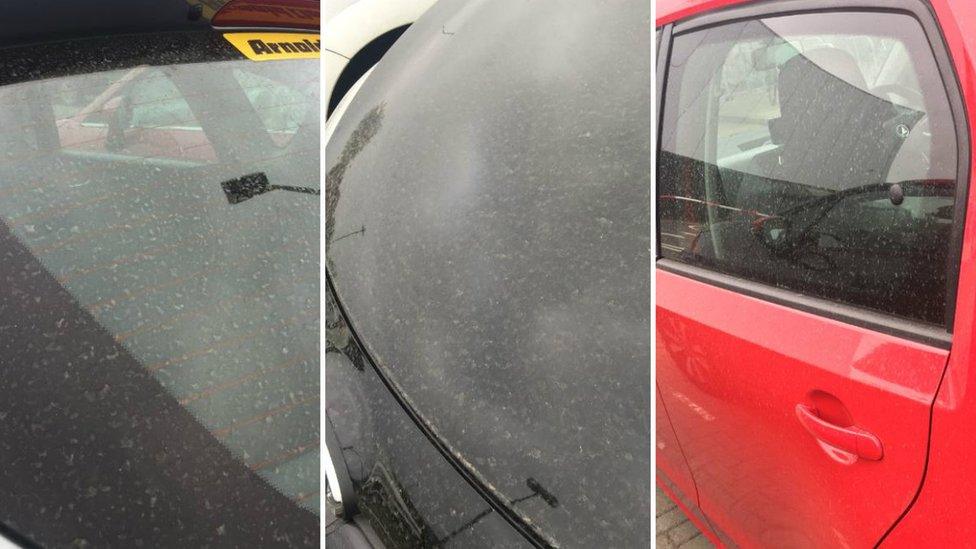Saharan dust: Why your car is covered in red dirt
- Published

Drivers discovered a thick layer of dust on their cars
Many drivers are asking why their cars are covered in red-coloured dirt - and the answer lies in Africa.
The Easter weekend's hot weather has brought not only record-breaking temperatures, but a dumping of dust from the Sahara desert.
The dust is carried in the air and can then come down as "blood rain", leaving the red deposits on everything it falls on.
It also created spectacular sunrises on Tuesday and Wednesday.
The red grit was on cars as people left work on Tuesday and came down in overnight showers.

The dust falls from the atmosphere with rain
Allow X content?
This article contains content provided by X. We ask for your permission before anything is loaded, as they may be using cookies and other technologies. You may want to read X’s cookie policy, external and privacy policy, external before accepting. To view this content choose ‘accept and continue’.

BBC Scotland weather forecaster Kawser Quamer said: "The thin layer of dust we are seeing deposited on our cars and windows is originally from the Sahara desert. This dust has been lifted in the Sahara by strong winds up to very high altitudes and then carried hundreds of miles to us thanks to the recent mild southerly airflow.
"The fine particles of sand get caught in rain droplets in clouds, falling to the ground when it rains. When the water evaporates, a thin layer of dust is left on surfaces, like cars as we have seen, not just in Scotland but across much of the UK and Europe too.
"It has also led to some vivid sunsets and sunrises as well."
And she thinks we could see more of it.
She said: "It is possible for some further Saharan dust to be deposited by the showers tonight and tomorrow, but then a cold front moves northeast across the UK bringing in some 'cleaner' air from the southwest."
People took to social media to post pictures of red skies and sunrises caused by the red dust.

Maud, a BBC Weather Watcher, caught this sunrise in Aberdeenshire on Tuesday

Another red sunrise, this time in Argyll and Bute

What is Saharan Dust?
As in other parts of the world, the wind can blow strongly over deserts - whipping up dust and sand high into the sky. If the winds in the upper part of the atmosphere are blowing north, the dust can be carried as far as the UK.
Once it is lifted from the ground by strong winds, clouds of dust can reach very high altitudes and be transported worldwide, covering thousands of miles.
In order for the dust to get from up in the sky down to the ground, you need something to wash it out of the sky - rain.
As raindrops fall, they collect particles of dust on the way down. Then when the raindrops land on something and eventually evaporate, they leave behind a layer of dust.
Saharan dust is relatively common in the UK often happening several times a year when big dust storms in the Sahara coincide with southerly wind patterns. In certain weather situations, Saharan dust can also affect air pollution and pollution levels.
Source: The Met Office

Saharan Dust can also affect air pollution levels which can be a problem for people who suffer from respiratory issues or heart problems.
Heavy dust can cause sore throats and eyes, but those with lung or heart disease may have to take extra steps to protect themselves.
Allow X content?
This article contains content provided by X. We ask for your permission before anything is loaded, as they may be using cookies and other technologies. You may want to read X’s cookie policy, external and privacy policy, external before accepting. To view this content choose ‘accept and continue’.

The weather phenomenon came after Scotland enjoyed its hottest Easter Monday on record with a top temperature of 24.2C (75.5F) in Kinlochewe in Wester Ross.
The figure beat the previous high of 21.4C (70.5F) from 2014.
It came 24 hours after a peak of 23.4C in Edinburgh broke Scotland's Easter Sunday record.
However, cooler weather is already spreading across the whole of Scotland and will continue during the rest of the week.
- Published16 October 2017
